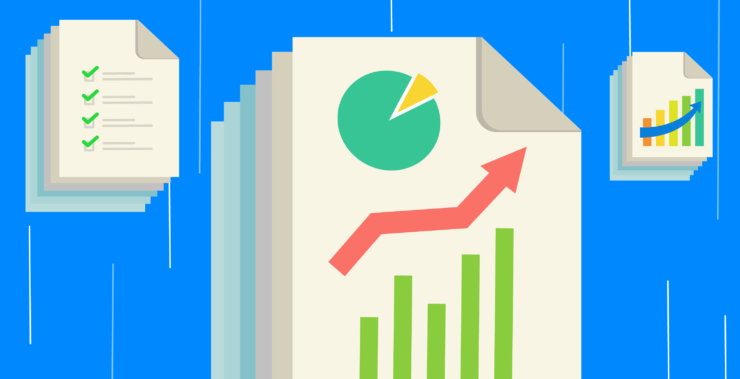Performance at work is crucial for companies to assess personnel productivity and monitor data on hard and soft skills, leadership qualities, and employees’ attitudes. Such analysis is helpful for both managers and the entire team. Here’s why:
- It helps to identify each specialist’s level and make informed decisions in HR management, such as who should be promoted and who should be more motivated.
- Managers and team leaders understand what personnel changes are needed in the organization and where to direct HR efforts.
- The motivation system and KPIs are improved and adjusted based on assessment data.
Indicators such as task complexity, resource expenditure, and deadlines are considered when assessing labor efficiency. For example, employees cope well with their job duties but do everything late and interrogate colleagues. Yes, they ultimately achieve the result, but with what efforts?
According to Gartner’s research, employers focus on a new HR management trend called “quiet hiring.” When a company does not expand its workforce, it emphasizes the talent pool and training of existing employees, which derives from work performance.
What Is Work Performance?
Employee work performance is measured in two categories: productivity and efficiency.
Work productivity shows the result the employee has achieved. Let’s take the customer support team as an example:
- How many customer inquiries did the support representative handle in a day?
- How many tickets did the support team resolve in a month?
Work efficiency shows the ratio between the achieved result and the cost of achieving it, including:
- How much money was spent on the support team, and how many customer satisfaction surveys resulted in positive feedback
- How many industry service awards the team received for outstanding customer service
Customer support teams in the same company may have the same productivity but different efficiency.
The Y support team handled inquiries through personalized email responses, which required more time and effort to craft each response. The X support team used a streamlined ticketing system with automated responses for common inquiries, allowing them to focus on more complex customer issues.
Both teams resolved the same number of tickets in 3 months. However, Y’s cost per resolution was higher than X’s. Y’s approach involved more manual work, leading to higher labor costs. X’s efficiency was higher due to automation, resulting in the same number of resolutions but with fewer costs, leading to greater overall efficiency.
How To Measure Work Performance?
By focusing on clear, measurable indicators, you can track progress, identify areas of improvement, and recognize achievements. Using tools like performance management software can help in organizing these metrics efficiently. Here are the most popular job performance indicators:
- Key Performance Indicators (KPIs). KPIs are quantifiable metrics. They gauge the effectiveness of a team or individual in achieving business objectives. They vary depending on the role and industry. Commonly, they include sales targets, customer satisfaction scores, and project completion rates. These metrics show how well an employee aligns with the company’s goals.
- Quality and accuracy. This metric assesses the precision and standard of an employee’s output. High levels of mistakes or rework suggest the need for training or process improvement.
- Productivity rates measure how efficiently an employee or team completes tasks within a set timeframe. For example, the number of guest post requests per day or fixed issues on the website. High productivity often indicates strong time management and process efficiency.
- Employee engagement. Measuring engagement through surveys, feedback, and participation in company activities offers insights into employee morale and satisfaction. Higher engagement levels typically correlate with good work performance.
- Absenteeism and punctuality. Frequent absences and tardiness can disrupt workflow. They signal underlying issues such as low job satisfaction or personal challenges. Tracking absenteeism and punctuality helps identify and address these patterns proactively.
These metrics must be monitored consistently. Only this way they will provide a comprehensive view of workplace performance.
6 Ways To Improve Work Performance
Regardless of your situation, we know universal strategies to improve work performance.
Set Clear Goals And Split Them Into Milestones
Source: Regenx Fitness and Nutrition
The SMART concept provides a framework for creating clear, attainable goals. Just compare the following goals:
- Improve customer satisfaction
- Increase customer satisfaction by 20% within the next quarter through faster response times and personalized support solutions
Feel the difference? This is how the SMART concept can change your goal setting. Then, break them into smaller milestones. This makes large tasks more manageable. It also gives you a sense of progress as you hit each milestone.
Suppose your goal is to launch a new product in six months. Your milestones might include:
- Research
- Development
- Prototyping
- Marketing strategy
- Iterations based on feedback
This approach keeps you on track, helps prevent overwhelm, and improves work performance.
Plan And Prioritize Smarter
Source: The Productivity Pedia
Start by identifying the most important tasks that impact your goals most. Use the Eisenhower Matrix to categorize tasks into 4 quadrants:
- Urgent and important
- Important but not urgent
- Urgent but not important
- Neither urgent nor important
Once you’ve prioritized your tasks, create a plan that allocates time and resources effectively. This might involve:
- Scheduling focused work sessions
- Delegating tasks to others
- Setting aside time for strategic thinking
The key is to ensure that your daily activities align with your long-term goals.
Work On Time Management
Undoubtedly, employees need to be supervised, but there are limits. Robby Slaughter, the owner of the Indianapolis-based consulting firm Accelawork, offers sound advice: let employees manage their own time, and they will be more productive. For those incapable of doing so and who need a supervisor with a whip, there’s no reason to keep them in their positions. It is the manager’s job to set clear goals and performance criteria.
Use The Power Of Feedback
The golden rule of team management states that employees should be praised in public and scolded in private. Bosses who neglect this rule undermine team cohesion and efficiency, and the professional development of such employees also comes to a grinding halt.
According to a Gallup survey, employees who were regularly given constructive feedback were 13% more productive. A team needs clear feedback to understand its prospects of working in a particular company.
Of course, monetary incentives such as a salary may be enough for the staff. However, informal ways to show gratitude are also essential. First and foremost, we are all human beings, and recognizing our successes and good attitudes profoundly touches us.
You can celebrate any achievement and quality work in front of the whole team with kind words, symbolically award it like a gift card, and assign the status of the best employee. And, of course, remember cash bonuses.
Boost And Unify All Work Communications
Communication barriers between management and staff create a significant risk. Even minor force majeure inevitably leads to downtime.
Establish regular check-ins or status updates. Unified communication channels also prevent information silos, where important details are only known to a few individuals. By making communication a priority, you enhance collaboration and reduce misunderstandings. Also, let your remote employees work securely with these 5 top tools for digital nomads.
Craft A Work Performance Improvement Plan
Source: Medium
A Work Performance Improvement Plan (PIP) is a structured approach to helping employees improve their performance. Steps to craft a PIP:
- Identify the performance issues that need to be addressed.
- Set clear, achievable goals for improvement. Here, the SMART framework is a must.
- Outline steps the employee will take to reach these goals. Define the resources they’ll need. These can be training, mentorship, or additional professional tools.
- Establish a timeline for reviewing progress. Incorporate check-ins to monitor the employee’s professional development.
Consider using 360-degree feedback software, which allows employees to receive constructive insights from colleagues and managers, fostering growth and skill enhancement.
A PIP’s goal is to address performance issues and help the employee succeed in their role.
3 Examples of Work Performance Improvement Plan
Here are three examples of work performance improvement.
Performance Improvement Plan Targeting Communication Issues
Employee name. Alex Manado
Manager name. Viktoria Hawk
Date. 26.09.2024
Reason for plan: The communication between the SEO agency and the client has become inconsistent. Misunderstandings and delays in project milestones occur. Key updates, changes, and progress reports are not being communicated effectively. Reports contain inaccurate data and sometimes lack valuable analytics. A lack of trust and alignment between the parties is present.
Performance expectations. The employee must establish clear, consistent communication with the client to ensure they are on the same page. This includes providing the client with precise, valuable reports, leveraging automated reporting tools like SEO report generator for timely delivery of SEO reports and providing accurate, up-to-date information. He also must schedule regular check-ins to discuss progress and address any concerns.
Performance metrics.
- Delivery of SEO reports within the agreed timeline for 100% of projects.
- Establishment of weekly or bi-weekly client meetings, with attendance and participation tracked.
- Reduction in client complaints related to communication by 80%.
Plan duration and review period. The plan will run for 60 days, with a review at 30 days to assess progress. Adjustments will be made as necessary to ensure goals are being met.
Consequences if goals aren’t met. Failure will result in termination.
Performance Improvement Plan Targeting Leadership Issues
Employee name. Sam Bamlton
Manager name. Nick Maxin
Date. 17.09.2024
Reason for plan. The employee has displayed a lack of leadership skills. This negatively impacted team morale and productivity. There are issues with delegation, decision-making, and providing clear direction to team members.
Performance expectations. The employee must develop and demonstrate stronger leadership skills. This includes effectively delegating tasks, making informed decisions in a timely manner, and offering clear, constructive feedback to team members.
Performance metrics.
- Improved team productivity by 15% within the next quarter.
- Completion of leadership training or coaching sessions within the first 30 days of the plan.
- Positive feedback from at least 80% of team members in the next internal survey.
Plan duration and review period. The plan will run for 90 days, with a review at 45 days to assess progress. Additional support or resources will be provided if needed.
Consequences if goals aren’t met. If the employee fails to show significant improvement in leadership, they may be reassigned to a non-leadership role or face termination.
Performance Improvement Plan Targeting Poor Quality Of Work Issues
Employee name. Monica Santos
Manager name. Andrew Tompson
Date. 30.09.2024
Reason for plan. The quality of the employee’s work has decreased. Frequent errors and missed deadlines are becoming a pattern. This has caused disruptions to project timelines and client dissatisfaction.
Performance expectations. The employee must improve the quality of their work by reducing errors and adhering to project deadlines. This includes thorough proofreading, attention to detail, and time management.
Performance metrics.
- Reduction of work errors by 90% over the next 60 days.
- On-time completion of 95% of assigned tasks within the plan period.
- Positive feedback from peers or clients on the quality of work delivered.
Plan duration and review period. The plan will run for 60 days, with a review at 30 days to monitor progress. Support will be provided in the form of mentoring or additional training if required.
Consequences if goals aren’t met. If there is no improvement, the employee may face further disciplinary action, including termination.
Summary
Employee work performance is how employees perform their duties and accomplish their necessary tasks.
Measuring and managing employee performance is crucial because it allows you to:
- Properly evaluate performance at work.
- Determine who is working hard and who is not.
- Determine how to properly compensate your workforce.
- Improve the overall productivity of your workplace.
While there are many small details to evaluate overall work performance, the main criteria are KPIs, quality and accuracy, productivity rates, employee engagement, absenteeism, and punctuality.
Create an effective system of KPIs, assess them regularly, and create action plans after assessments to encourage better work performance of your employees.








